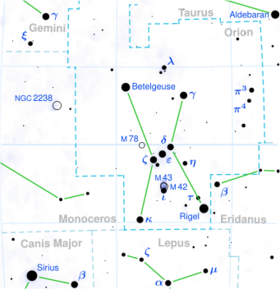Astronomy:31 Orionis
| Observation data Equinox J2000.0]] (ICRS) | |
|---|---|
| Constellation | Orion |
| Right ascension | 05h 29m 43.98147s[1] |
| Declination | −01° 05′ 32.0582″[1] |
| Apparent magnitude (V) | 4.71[2] + 10.2[3] |
| Characteristics | |
| Spectral type | K5III[4] + F7V[3] |
| U−B color index | +1.91[5] |
| B−V color index | +1.58[5] |
| Variable type | SR?[6][7] |
| Astrometry | |
| Radial velocity (Rv) | +6.02±0.15[1] km/s |
| Proper motion (μ) | RA: +1.242[1] mas/yr Dec.: −25.476[1] mas/yr |
| Parallax (π) | 6.6135 ± 0.2293[1] mas |
| Distance | 490 ± 20 ly (151 ± 5 pc) |
| Absolute magnitude (MV) | −1.23[2] |
| Details | |
| 31 Ori A | |
| Mass | 5.2[8] M☉ |
| Radius | 62[8] R☉ |
| Luminosity | 1,361[8] L☉ |
| Surface gravity (log g) | 0.92[8] cgs |
| Temperature | 4,610[8] K |
| Metallicity [Fe/H] | −0.21[2] dex |
| Rotational velocity (v sin i) | 2.7[9] km/s |
| 31 Ori B | |
| Mass | 1.1[10] M☉ |
| Radius | 1.2[10] R☉ |
| Luminosity | 1.9[10] L☉ |
| Surface gravity (log g) | 4.24[10] cgs |
| Temperature | 6,111[10] K |
| Age | 3.9[10] Gyr |
| Other designations | |
| Database references | |
| SIMBAD | data |
31 Orionis is a binary star[3] system in the equatorial constellation of Orion, located near the bright star Mintaka. It is visible to the naked eye as a faint, orange-hued point of light with a baseline apparent visual magnitude of 4.71.[2] The distance to this system is approximately 490 light years away based on parallax,[1] and it is drifting further away with a mean radial velocity of +6 km/s.[1]
As of 2008, the pair had an angular separation of 12.7″.[3] The brighter member, designated component A, is an aging giant star with a stellar classification of K5III.[4] It is reported as a semi-regular variable with magnitude ranging from 4.68 to 4.72 over 141 days,[6] although the General Catalogue of Variable Stars describes this as unconfirmed by subsequent observations.[7] It has the variable star designation CI Orionis, while 31 Orionis is the Flamsteed designation. The magnitude 10.2 companion star, component B, is an F-type main-sequence star with a class of F7V.[3]
References
- ↑ 1.0 1.1 1.2 1.3 1.4 1.5 1.6 1.7 Brown, A. G. A. (August 2018). "Gaia Data Release 2: Summary of the contents and survey properties". Astronomy & Astrophysics 616: A1. doi:10.1051/0004-6361/201833051. Bibcode: 2018A&A...616A...1G. Gaia DR2 record for this source at VizieR.
- ↑ 2.0 2.1 2.2 2.3 Anderson, E.; Francis, Ch. (2012). "XHIP: An extended hipparcos compilation". Astronomy Letters 38 (5): 331. doi:10.1134/S1063773712050015. Bibcode: 2012AstL...38..331A. Vizier catalog entry
- ↑ 3.0 3.1 3.2 3.3 3.4 Eggleton, P. P.; Tokovinin, A. A. (2008). "A catalogue of multiplicity among bright stellar systems". Monthly Notices of the Royal Astronomical Society 389 (2): 869. doi:10.1111/j.1365-2966.2008.13596.x. Bibcode: 2008MNRAS.389..869E. Vizier catalog entry
- ↑ 4.0 4.1 Hoffleit, D.; Warren, W. H. (1995). "VizieR Online Data Catalog: Bright Star Catalogue, 5th Revised Ed. (Hoffleit+, 1991)". VizieR On-line Data Catalog: V/50. Originally Published in: 1964BS....C......0H 5050. Bibcode: 1995yCat.5050....0H.
- ↑ 5.0 5.1 Mermilliod, J. C. (2006). "Homogeneous Means in the UBV System (Mermilliod 1991)". VizieR On-line Data Catalog: II/168. Originally Published in: Institut d'Astronomie 2168. Bibcode: 2006yCat.2168....0M.Vizier catalog entry
- ↑ 6.0 6.1 "CI Ori". AAVSO – American Association of Variable Star Observers. http://www.aavso.org/vsx/index.php?view=detail.top&oid=23173.
- ↑ 7.0 7.1 Samus, N. N. et al. (2009). "General Catalogue of Variable Stars (Samus+ 2007-2013)". VizieR On-line Data Catalog: B/gcvs 1. Bibcode: 2009yCat....102025S.
- ↑ 8.0 8.1 8.2 8.3 8.4 Vallenari, A. et al. (2022). "Gaia Data Release 3. Summary of the content and survey properties". Astronomy & Astrophysics. doi:10.1051/0004-6361/202243940 Gaia DR3 record for this source at VizieR.
- ↑ De Medeiros, J. R.; Alves, S.; Udry, S.; Andersen, J.; Nordström, B.; Mayor, M. (2014). "A catalog of rotational and radial velocities for evolved stars". Astronomy & Astrophysics 561: A126. doi:10.1051/0004-6361/201220762. Bibcode: 2014A&A...561A.126D. Vizier catalog entry
- ↑ 10.0 10.1 10.2 10.3 10.4 10.5 Vallenari, A. et al. (2022). "Gaia Data Release 3. Summary of the content and survey properties". Astronomy & Astrophysics. doi:10.1051/0004-6361/202243940 Gaia DR3 record for this source at VizieR.
- ↑ "31 Ori". SIMBAD. Centre de données astronomiques de Strasbourg. http://simbad.u-strasbg.fr/simbad/sim-basic?Ident=31+Ori.
- ↑ "/ftp/cats/more/HIP/cdroms/cats". Strasbourg astronomical Data Center. https://cdsarc.cds.unistra.fr/viz-bin/ftp-index?/ftp/cats/more/HIP/cdroms/cats.
 |



